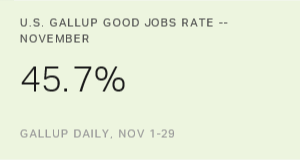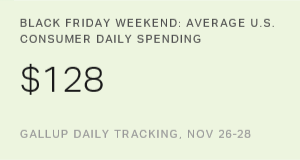Story Highlights
- Gallup Good Jobs rate is the highest recorded for any November
- Unemployment is the lowest in Gallup's trend, at 4.9%
- Workforce participation falls to 67.5%
WASHINGTON, D.C. -- The Gallup Good Jobs (GGJ) rate in the U.S. was 45.7% in November, down from 46.4% in October. However, the November estimate is nearly a full percentage point higher than the 44.9% recorded in November 2015 and is higher than any GGJ rate recorded for the month of November since Gallup began tracking this measure in 2010.
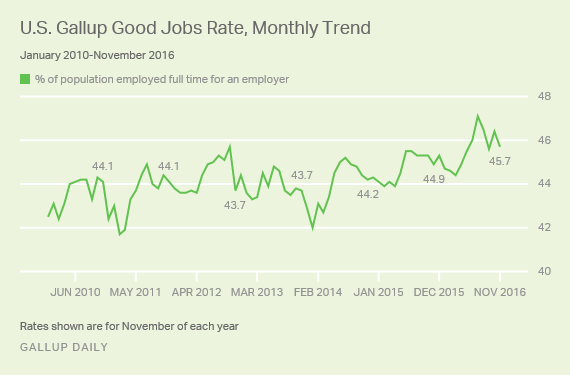
The slight dip in the GGJ rate from October to November is in line with normal seasonal patterns. GGJ typically peaks in June and July with summer employment and then drops in the fall, with a limited uptick in October. The current GGJ rate is below the record high of 47.1% reached in July 2016.
The latest results are based on Gallup Daily tracking interviews with 27,403 U.S. adults, conducted Nov. 1-29 by landline telephone and cellphone. The GGJ metric tracks the percentage of U.S. adults, aged 18 and older, who work for an employer full time -- at least 30 hours per week. Gallup does not count adults who are self-employed, who work fewer than 30 hours per week, who are unemployed or who are out of the workforce as payroll-employed in the GGJ metric. The Gallup Good Jobs metric does not take into account factors such as job satisfaction or salary level, and solely reflects full-time employment for an employer. GGJ is not seasonally adjusted.
Gallup first measured the GGJ rate in January 2010, a time of high unemployment (10.9%). At that point, 42.5% of Americans were employed full time by an employer. GGJ fell to a low of 41.7% in February 2011 but then improved over the next few months. Before this year, the previous high was 45.7% in October 2012.
Since January 2010, GGJ has generally trended upward. The exception was November 2012 to April 2014, when the measure registered year-over-year decreases. Since May 2014, the GGJ rate has once again registered year-over-year increases almost every month.
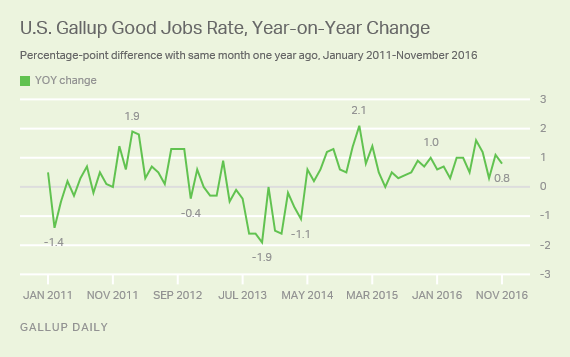
Workforce Participation Falls to 67.5% in November
The percentage of U.S. adults who participated in the workforce in November in any capacity -- by working full time, working part time, or not working but actively seeking and being available for work -- was 67.5%, down almost a full point from 68.4% in October and even with September.
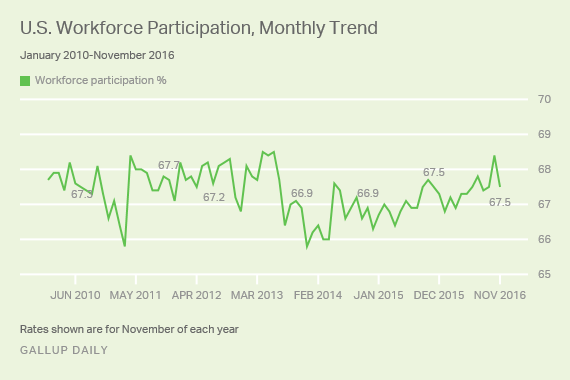
Unemployment Rate Is 4.9%, Lowest in Gallup Trend
Gallup's unadjusted U.S. unemployment rate in November was 4.9%, edging down from 5.1% in October and the lowest reading since Gallup began tracking it in 2010.
Gallup's U.S. unemployment rate represents the percentage of adults in the workforce who did not have any paid work in the past seven days, either for an employer or for themselves, and who were actively looking for and available to work.
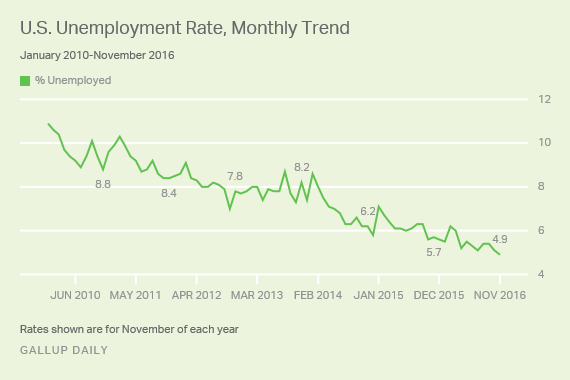
Unlike the Gallup Good Jobs rate, which is a percentage of the total population, the unemployment rates that Gallup and the U.S. Bureau of Labor Statistics (BLS) report are percentages of the labor force, defined as those who are working or seeking work. While both Gallup and BLS data are based on surveys with large sample sizes, the two have important methodological differences outlined at the end of this article. Additionally, the unemployment rate released by the BLS each month is seasonally adjusted, while Gallup reports unadjusted numbers. Although Gallup's unemployment numbers strongly correlate with BLS rates, the BLS and Gallup estimates of unemployment do not always track precisely on a monthly basis.
Underemployment Rises to 13.2%
Gallup's measure of underemployment in November was 13.2%, up nominally from 12.7% in October. Gallup's U.S. underemployment rate combines the percentage of adults in the workforce who are unemployed (4.9%) with those who are working part time but desire full-time work (8.3%).
Despite a 0.2-point drop in unemployment, involuntary part-time work increased by 0.7 points, driving the underemployment figure up. Underemployment was roughly 20% when Gallup started measuring it in January 2010.

Bottom Line
The Gallup Good Jobs rate in November 2016 was the highest in any November since Gallup began tracking it in 2010. At the same time, the unemployment rate was the lowest of any month in Gallup's trend. These achievements fit with the trend seen over the last 12 months, whereby the GGJ rate has hit a new high each month since November 2015 compared with the same month in Gallup's trend. That included the high point across all months of 47.1% in July.
More broadly, full-time employment for an employer generally has grown year over year since May 2014, following a year and a half of mostly negative growth. Workforce participation declined in November but overall has trended upward since early 2014. Unemployment has slowly declined, though the decline in November was driven in part by the decline in workforce participation and not by an increase in those finding work.
Taken together, these trends demonstrate strength in the U.S. labor market. Even so, after the 2012 presidential election, year-over-year growth in the GGJ rate ended and languished for upward of a year. The drop this year from October to November is in line with both the last presidential election year's pattern and annual seasonal patterns, so the coming months will show whether 2016 repeats or defies that history.
The data in this article are available in Gallup Analytics.
| Most recent month (Nov '16) | Previous month (Oct '16) | Month a year ago (Nov '15) | |||||||||||||||||||||||||||||||||||||||||||||||||||||||||||||||||||||||||||||||||||||||||||||||||
|---|---|---|---|---|---|---|---|---|---|---|---|---|---|---|---|---|---|---|---|---|---|---|---|---|---|---|---|---|---|---|---|---|---|---|---|---|---|---|---|---|---|---|---|---|---|---|---|---|---|---|---|---|---|---|---|---|---|---|---|---|---|---|---|---|---|---|---|---|---|---|---|---|---|---|---|---|---|---|---|---|---|---|---|---|---|---|---|---|---|---|---|---|---|---|---|---|---|---|---|
| Employed full time for employer (GGJ)* | 45.7% | 46.4% | 44.9% | ||||||||||||||||||||||||||||||||||||||||||||||||||||||||||||||||||||||||||||||||||||||||||||||||
| Employed full time for self* | 5.5% | 5.7% | 5.5% | ||||||||||||||||||||||||||||||||||||||||||||||||||||||||||||||||||||||||||||||||||||||||||||||||
| Workforce participation rate* | 67.5% | 68.4% | 67.5% | ||||||||||||||||||||||||||||||||||||||||||||||||||||||||||||||||||||||||||||||||||||||||||||||||
| Unemployment rate** | 4.9% | 5.1% | 5.7% | ||||||||||||||||||||||||||||||||||||||||||||||||||||||||||||||||||||||||||||||||||||||||||||||||
| Employed part time, wanting full time** | 8.3% | 7.6% | 8.9% | ||||||||||||||||||||||||||||||||||||||||||||||||||||||||||||||||||||||||||||||||||||||||||||||||
| Underemployment rate** | 13.2% | 12.7% | 14.6% | ||||||||||||||||||||||||||||||||||||||||||||||||||||||||||||||||||||||||||||||||||||||||||||||||
| *Metrics represent percentages of the population aged 18+ who have a job or are actively seeking work. **Metrics represent percentages of the workforce. | |||||||||||||||||||||||||||||||||||||||||||||||||||||||||||||||||||||||||||||||||||||||||||||||||||
| Gallup Daily | |||||||||||||||||||||||||||||||||||||||||||||||||||||||||||||||||||||||||||||||||||||||||||||||||||
| Gallup | U.S. Bureau of Labor Statistics | ||||||||||||||||||||||||||||||||||||||||||||||||||||||||||||||||||||||||||||||||||||||||||||||||||
|---|---|---|---|---|---|---|---|---|---|---|---|---|---|---|---|---|---|---|---|---|---|---|---|---|---|---|---|---|---|---|---|---|---|---|---|---|---|---|---|---|---|---|---|---|---|---|---|---|---|---|---|---|---|---|---|---|---|---|---|---|---|---|---|---|---|---|---|---|---|---|---|---|---|---|---|---|---|---|---|---|---|---|---|---|---|---|---|---|---|---|---|---|---|---|---|---|---|---|---|
| Population | 18 and older | 16 and older | |||||||||||||||||||||||||||||||||||||||||||||||||||||||||||||||||||||||||||||||||||||||||||||||||
| Adjustments | Not seasonally adjusted | Seasonally adjusted | |||||||||||||||||||||||||||||||||||||||||||||||||||||||||||||||||||||||||||||||||||||||||||||||||
| Sample size | 30,000 individuals per month | 60,000 households per month | |||||||||||||||||||||||||||||||||||||||||||||||||||||||||||||||||||||||||||||||||||||||||||||||||
| Mode of interview | RDD telephone, including cellphones | Rotating panel with face-to-face and telephone interviewing | |||||||||||||||||||||||||||||||||||||||||||||||||||||||||||||||||||||||||||||||||||||||||||||||||
| Data collection period | Continuous | One-week reference period during mid-month | |||||||||||||||||||||||||||||||||||||||||||||||||||||||||||||||||||||||||||||||||||||||||||||||||
| Reporting frequency | Daily, weekly and monthly, based on 30-day rolling averages | Monthly, based on one-week reference period | |||||||||||||||||||||||||||||||||||||||||||||||||||||||||||||||||||||||||||||||||||||||||||||||||
| Gallup | |||||||||||||||||||||||||||||||||||||||||||||||||||||||||||||||||||||||||||||||||||||||||||||||||||
Gallup.com reports results from these indexes in daily, weekly and monthly averages and in Gallup.com stories. Complete trend data are always available to view in the following charts:
Daily: Employment, Economic Confidence and Job Creation, Consumer Spending
Weekly: Employment, Economic Confidence, Job Creation, Consumer Spending
Read more about Gallup's economic measures.
View our economic release schedule.
Survey Methods
Results for this Gallup poll are based on telephone interviews conducted Nov. 1-29, 2016, on the Gallup Daily tracking survey, with a random sample of 27,403 adults, aged 18 and older, living in all 50 U.S. states and the District of Columbia. For results based on the total sample of national adults, the margin of sampling error is ±1 percentage point at the 95% confidence level. All reported margins of sampling error include computed design effects for weighting.
Each sample of national adults includes a minimum quota of 60% cellphone respondents and 40% landline respondents, with additional minimum quotas by time zone within region. Landline and cellular telephone numbers are selected using random-digit-dial methods.
Learn more about how Gallup Daily tracking works.
